Williamsburg, in North Brooklyn, is the enclave of the most insular of the
Orthodox Hasidic Jews - the
Satmar hasids. Hasidic Jewish tradition is centered around the person of a
Rebbe, who is somthing more than what most people think of when using the term rabbi... A
Rebbe is not only learned, he leads of a group of pious Hasidic Jews and usually descended from one of the original followers of Rabbi Israel Ben Eliezer (1698–1760), the
Baal Shem Tov (also known as the BeSHT) who founded and inspired Hasidism in the early 18th century in east Europe.
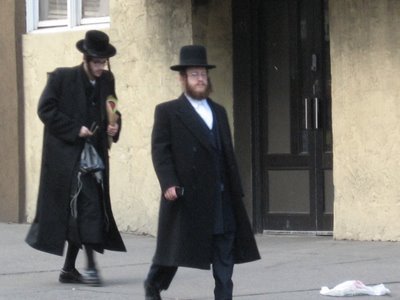
There are many hasidic groups today, all of whom maintain a presence in one of Brooklyn's three main hasidic neighborhoods (Williamsburg, Boro Park, and the predominantly Lubavitch Crown Heights) known as "courts" (
hoyfn in Yiddish) and the "Hungarian" hasids are dominated by the
hoyf of Satmar. Satmar originates from the court of the Teitelbaum rabbinic dynasty based in Satu Mare, Romania (once part of Hungary and known as Szatmár.) Satmar is what most hasids mean when they talk about "the Hungarians" - pretty much in the same tone of voice that everybody else in east Europe uses when talking about "the Hungarians." They are insular. Argumentative. Impenetrable. Intransigent about language. But they have very good pastries and cakes.

After the destruction of Hungary and Transylvania's Jews during World War Two, the remnants of the Satmar and other hasids moved to New York. Satmar is famous for its
opposition to the secular state of Israel, based on the teachings of the Rabbi Itzik Traub of Nagykallo (near Debrecen) known as the "
Kalever Rebbe" which define the conditions for the return of the Messiah to earth. Since Israel was not formed by divine Messianic decree, the existence of the Zionist State isn't considered by Satmar to be
legitimate, and the Satmars prefer to reside near their rebbes in Brooklyn, althgough many do travel to and reside in Israel in the Mea Shearim area of Jerusalem and Bnei Brak near Tel Aviv. One faction formed the anti-Zionist organization
Neturei Karta, which recently sent a delegation to Iran to meet with President
Ahmadinejad of Iran. Drive a car around Williamsburg on a Saturday and you may just have a rock thrown at you. Satmars are serious business.
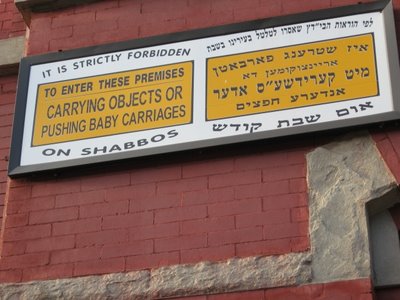
All in all, not your everyday, boring little ethno-religious Brooklyn enclave. In terms of conservatism, Williamsburg is it. Satmar families are huge - the streets are crowded with baby carriages. There are about 150,000 Satmars in the world today, far more than there were before WWII. The Satmars feel that since Hitler tried to wipe them out, they would rebound with a vengence. Families with eight kids are common. Satmar is about
outbreeding the Holocaust - they are the largest of Hasidic sects today. Other Jews may look at them with with distaste or even hatred - for their insularity, for their "backwardness" or for their anti-Zionist views - but I agree with what Michael Alpert said of them: if not for them, we would have almost completely lost our window on east European Jewishness,
yiddishkeit, after the Holocaust. They preserve it with a vengence. Williamsburg, for example, is the largest concentration of Yiddish speakers in the World today. Need a cab? Try the "
Nay Brooklyn Car Servis, 24 sho servis"
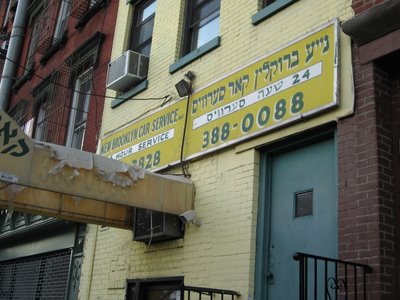
The Satmar schools teach in Yiddish, as Hebrew is considered too holy for everyday communication. Many of the schools and Yeshivas are the direct organizational descendants of previously existing schools in the old country. Pupa is the legacy of the Yeshiva in Pápa, a town in the Bakony region of west Hungary.

Of course, you couldn't go without some extremely kosher matzoh bread from the Pupa/Pápa traditional bakery on Bedford Avenue.
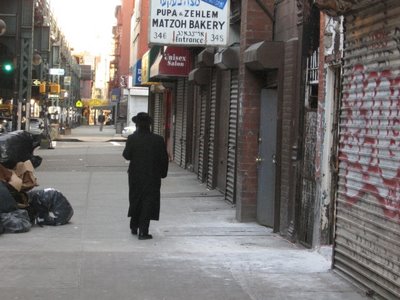
The Satmar Girls School.
Pearl Gluck, whose independant film "
Divan: The Couch" looks at what it is like to grow up Satmar in Brooklyn, went to such a school in Boro Park. Pearl is modernity's
window on Satmar. Check out the film. Some of
Di Naye's music is used in it.
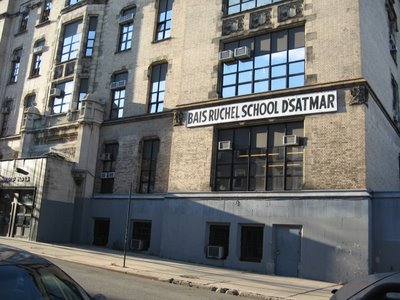 Săpânţa
Săpânţa is a town just in the Marmures region of Romania. Known for its
cemetery - a folk art treasure called the "Happy Cemetery" - it was called
Shpinka in Yiddish.
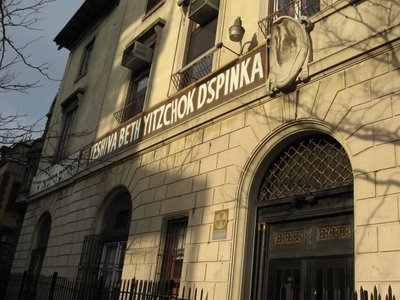
Many of the smaller Hasidic groups maintain small prayer houses -
shtibele - such as this, the
kloys of the Boyaner Hasidim, who originate in Bukovina.

Williamsburg is a pretty self-contained world. You get sick, you want a
kosher ambulance service.
 And ye shall know them by their hats.
And ye shall know them by their hats. Different groups of Hasids wear different styles of dress. Satmar are into knickers and flat toped felt hats. The only other place in theworld where one can see this many odd, flat-topped hats is in eastern Marmures on a Sunday.
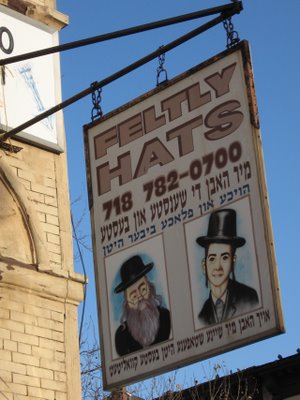
Satmars take their hats very seriously. All hasids do. Lubavitch like fedoras, Bobov like bowlers, non-hasidic Litvaks like gigantic fedoras that would make the
Romanian Gaboresti green with envy. And they have to fit perfectly in order to wear a yarmulke underneath. On Saturday - Shabbos - out come the
striemels and
pelzes, big flat fur hats that are the pride of all hasidic adult men.
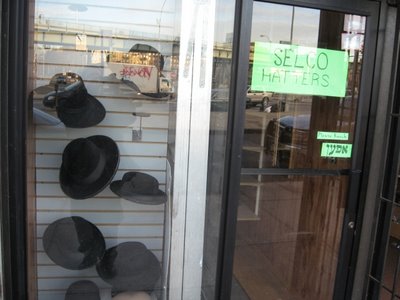
Williamsburg is also the last place outside of east Europe where men regularly wear
kucsma, the furry winter hats. This shop is across the street from the new, hip area of Williamsburg. Rappers Jay-Z and Buster Rhymes have both bought trendy lofts within a couple of blocks of this shop.
Wort!
Shulem af di velt,
oys, y'all.
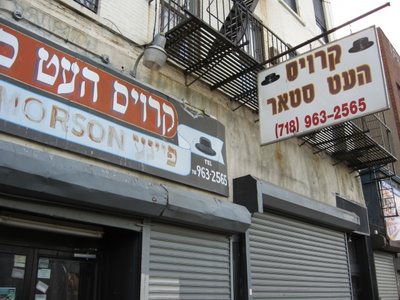
 There are many hasidic groups today, all of whom maintain a presence in one of Brooklyn's three main hasidic neighborhoods (Williamsburg, Boro Park, and the predominantly Lubavitch Crown Heights) known as "courts" (hoyfn in Yiddish) and the "Hungarian" hasids are dominated by the hoyf of Satmar. Satmar originates from the court of the Teitelbaum rabbinic dynasty based in Satu Mare, Romania (once part of Hungary and known as Szatmár.) Satmar is what most hasids mean when they talk about "the Hungarians" - pretty much in the same tone of voice that everybody else in east Europe uses when talking about "the Hungarians." They are insular. Argumentative. Impenetrable. Intransigent about language. But they have very good pastries and cakes.
There are many hasidic groups today, all of whom maintain a presence in one of Brooklyn's three main hasidic neighborhoods (Williamsburg, Boro Park, and the predominantly Lubavitch Crown Heights) known as "courts" (hoyfn in Yiddish) and the "Hungarian" hasids are dominated by the hoyf of Satmar. Satmar originates from the court of the Teitelbaum rabbinic dynasty based in Satu Mare, Romania (once part of Hungary and known as Szatmár.) Satmar is what most hasids mean when they talk about "the Hungarians" - pretty much in the same tone of voice that everybody else in east Europe uses when talking about "the Hungarians." They are insular. Argumentative. Impenetrable. Intransigent about language. But they have very good pastries and cakes.  After the destruction of Hungary and Transylvania's Jews during World War Two, the remnants of the Satmar and other hasids moved to New York. Satmar is famous for its opposition to the secular state of Israel, based on the teachings of the Rabbi Itzik Traub of Nagykallo (near Debrecen) known as the "Kalever Rebbe" which define the conditions for the return of the Messiah to earth. Since Israel was not formed by divine Messianic decree, the existence of the Zionist State isn't considered by Satmar to be legitimate, and the Satmars prefer to reside near their rebbes in Brooklyn, althgough many do travel to and reside in Israel in the Mea Shearim area of Jerusalem and Bnei Brak near Tel Aviv. One faction formed the anti-Zionist organization Neturei Karta, which recently sent a delegation to Iran to meet with President Ahmadinejad of Iran. Drive a car around Williamsburg on a Saturday and you may just have a rock thrown at you. Satmars are serious business.
After the destruction of Hungary and Transylvania's Jews during World War Two, the remnants of the Satmar and other hasids moved to New York. Satmar is famous for its opposition to the secular state of Israel, based on the teachings of the Rabbi Itzik Traub of Nagykallo (near Debrecen) known as the "Kalever Rebbe" which define the conditions for the return of the Messiah to earth. Since Israel was not formed by divine Messianic decree, the existence of the Zionist State isn't considered by Satmar to be legitimate, and the Satmars prefer to reside near their rebbes in Brooklyn, althgough many do travel to and reside in Israel in the Mea Shearim area of Jerusalem and Bnei Brak near Tel Aviv. One faction formed the anti-Zionist organization Neturei Karta, which recently sent a delegation to Iran to meet with President Ahmadinejad of Iran. Drive a car around Williamsburg on a Saturday and you may just have a rock thrown at you. Satmars are serious business. All in all, not your everyday, boring little ethno-religious Brooklyn enclave. In terms of conservatism, Williamsburg is it. Satmar families are huge - the streets are crowded with baby carriages. There are about 150,000 Satmars in the world today, far more than there were before WWII. The Satmars feel that since Hitler tried to wipe them out, they would rebound with a vengence. Families with eight kids are common. Satmar is about outbreeding the Holocaust - they are the largest of Hasidic sects today. Other Jews may look at them with with distaste or even hatred - for their insularity, for their "backwardness" or for their anti-Zionist views - but I agree with what Michael Alpert said of them: if not for them, we would have almost completely lost our window on east European Jewishness, yiddishkeit, after the Holocaust. They preserve it with a vengence. Williamsburg, for example, is the largest concentration of Yiddish speakers in the World today. Need a cab? Try the "Nay Brooklyn Car Servis, 24 sho servis"
All in all, not your everyday, boring little ethno-religious Brooklyn enclave. In terms of conservatism, Williamsburg is it. Satmar families are huge - the streets are crowded with baby carriages. There are about 150,000 Satmars in the world today, far more than there were before WWII. The Satmars feel that since Hitler tried to wipe them out, they would rebound with a vengence. Families with eight kids are common. Satmar is about outbreeding the Holocaust - they are the largest of Hasidic sects today. Other Jews may look at them with with distaste or even hatred - for their insularity, for their "backwardness" or for their anti-Zionist views - but I agree with what Michael Alpert said of them: if not for them, we would have almost completely lost our window on east European Jewishness, yiddishkeit, after the Holocaust. They preserve it with a vengence. Williamsburg, for example, is the largest concentration of Yiddish speakers in the World today. Need a cab? Try the "Nay Brooklyn Car Servis, 24 sho servis"  The Satmar schools teach in Yiddish, as Hebrew is considered too holy for everyday communication. Many of the schools and Yeshivas are the direct organizational descendants of previously existing schools in the old country. Pupa is the legacy of the Yeshiva in Pápa, a town in the Bakony region of west Hungary.
The Satmar schools teach in Yiddish, as Hebrew is considered too holy for everyday communication. Many of the schools and Yeshivas are the direct organizational descendants of previously existing schools in the old country. Pupa is the legacy of the Yeshiva in Pápa, a town in the Bakony region of west Hungary.  Of course, you couldn't go without some extremely kosher matzoh bread from the Pupa/Pápa traditional bakery on Bedford Avenue.
Of course, you couldn't go without some extremely kosher matzoh bread from the Pupa/Pápa traditional bakery on Bedford Avenue.  The Satmar Girls School. Pearl Gluck, whose independant film "Divan: The Couch" looks at what it is like to grow up Satmar in Brooklyn, went to such a school in Boro Park. Pearl is modernity's window on Satmar. Check out the film. Some of Di Naye's music is used in it.
The Satmar Girls School. Pearl Gluck, whose independant film "Divan: The Couch" looks at what it is like to grow up Satmar in Brooklyn, went to such a school in Boro Park. Pearl is modernity's window on Satmar. Check out the film. Some of Di Naye's music is used in it. Săpânţa is a town just in the Marmures region of Romania. Known for its cemetery - a folk art treasure called the "Happy Cemetery" - it was called Shpinka in Yiddish.
Săpânţa is a town just in the Marmures region of Romania. Known for its cemetery - a folk art treasure called the "Happy Cemetery" - it was called Shpinka in Yiddish.  Many of the smaller Hasidic groups maintain small prayer houses - shtibele - such as this, the kloys of the Boyaner Hasidim, who originate in Bukovina.
Many of the smaller Hasidic groups maintain small prayer houses - shtibele - such as this, the kloys of the Boyaner Hasidim, who originate in Bukovina.  Williamsburg is a pretty self-contained world. You get sick, you want a kosher ambulance service.
Williamsburg is a pretty self-contained world. You get sick, you want a kosher ambulance service. And ye shall know them by their hats. Different groups of Hasids wear different styles of dress. Satmar are into knickers and flat toped felt hats. The only other place in theworld where one can see this many odd, flat-topped hats is in eastern Marmures on a Sunday.
And ye shall know them by their hats. Different groups of Hasids wear different styles of dress. Satmar are into knickers and flat toped felt hats. The only other place in theworld where one can see this many odd, flat-topped hats is in eastern Marmures on a Sunday. Satmars take their hats very seriously. All hasids do. Lubavitch like fedoras, Bobov like bowlers, non-hasidic Litvaks like gigantic fedoras that would make the Romanian Gaboresti green with envy. And they have to fit perfectly in order to wear a yarmulke underneath. On Saturday - Shabbos - out come the striemels and pelzes, big flat fur hats that are the pride of all hasidic adult men.
Satmars take their hats very seriously. All hasids do. Lubavitch like fedoras, Bobov like bowlers, non-hasidic Litvaks like gigantic fedoras that would make the Romanian Gaboresti green with envy. And they have to fit perfectly in order to wear a yarmulke underneath. On Saturday - Shabbos - out come the striemels and pelzes, big flat fur hats that are the pride of all hasidic adult men. Williamsburg is also the last place outside of east Europe where men regularly wear kucsma, the furry winter hats. This shop is across the street from the new, hip area of Williamsburg. Rappers Jay-Z and Buster Rhymes have both bought trendy lofts within a couple of blocks of this shop. Wort! Shulem af di velt, oys, y'all.
Williamsburg is also the last place outside of east Europe where men regularly wear kucsma, the furry winter hats. This shop is across the street from the new, hip area of Williamsburg. Rappers Jay-Z and Buster Rhymes have both bought trendy lofts within a couple of blocks of this shop. Wort! Shulem af di velt, oys, y'all.
14 comments:
Aha! No more advertising comments! ust type the word you see below, we don't need no stinking ad-bots.
Wow... so much stuff I never knew!
I used to live in this neighborhood. People are really rude unless you're wearing a t-shirt with hebrew on it. Then they are really, really nice.
hey there :) not sure but i think we have the next biggest (satmar) community after new york, here in montreal. we have several different groups (sects) mostly living in outremont. great post. you always provide such fascinating information and pictures. hag same'ach.
My mother, tzum lahnge yohren, is from Nagykallo. I would like to get the COMPLETE (over six verses) and correctly accented words to "Szol a Kakas Mar". The versions I have found on the Internet all run only four to six verses, and from the fifth verse differ slightly from each other.
This is for the purpose of finalizing and publishing my singable English version, the first draft of which currently runs to seven verses. So I would like to obtain the most authoritative and comprehensive version possible. (And yes, I am projecting Hebrew and better Yiddish versions. At least. Maybe French too.)
Any help will be greatly appreciated.
Please respond by e-mail to
chayaweiss@hotmail.com
Thanks in advance,
Chaya Weiss
Toronto
Well done. I enjoyed your commentary on the Satmar of Williamsburg. I will be going to Williamsburg shortly to visit, and it was fine introduction to know some things to expect of the community there.
During the 30+ years that I live in Williamsburg I have never, ever seen anyone throw a rock at a passing car on Shabbos (Saturday) or any other day of the week.
Actually, in Elsternwick and Balaclava in Melbourne, Australia, one can see many Satmar men in full regalia, silk knickers and coat, shtriemel etc. When it gets to 105 degrees you admire their sartorial commitment.
What kind of hat is a plotchik? It's in a book I'm reading and I have not neen able to get a translation. I can't even find it in the Yiddish doctionary I located online. TIA
I think you're right about Outremont. I've heard Montreal has more Holocaust survivors than anywhere outside of Istael so this would not be surprising
A wide, flat velvet hat
Post a Comment